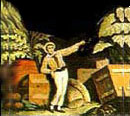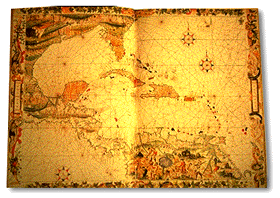| HOME |
| HISTORY, ARTS AND CULTURE |
 |
Slavery left a bitter legacy on Antigua. "Freedom" came on August 1, 1834, but the lack of an "apprenticeship" or transition period left former slaves instantly impoverished. They had no choice but to continue working on the sugar plantations, where conditions and wages kept them dependent on their former masters. |
|
Most Antiguans are of African lineage, descendants of slaves brought to the island centuries ago to labor in the sugarcane fields. However, Antigua's history of habitation extends as far back as two and a half millenia before Christ. The first settlements, dating from about 2400 B.C., were those of the Siboney (an Arawak word meaning "stone-people"), peripatetic Meso-Indians whose beautifully crafted shell and stone tools have been found at dozens of sites around the island. Long after the Siboney had moved on, Antigua was settled by the pastoral, agricultural Arawaks (35-1100 A.D.), who were then displaced by the Caribs--an aggressive people who ranged all over the Caribbean. The earliest European contact with the island was made by Christopher Columbus during his second Caribbean voyage (1493), who sighted the island in passing and named it after Santa Maria la Antigua, the miracle-working saint of Seville. European settlement, however, didn't occur for over a century, largely because of Antigua's dearth of fresh water and abundance of determined Carib resistance. Finally, in 1632, a group of Englishmen from St. Kitts established a successful settlement, and in 1684, with Codrington's arrival, the island entered the sugar era. By the end of the eighteenth century Antigua had become an important strategic port as well as a valuable commercial colony. Known as the "gateway to the Caribbean," it was situated in a position that offered control over the major sailing routes to and from the region's rich island colonies. Most of the island's historical sites, from its many ruined fortifications to the impeccably-restored architecture of English Harbourtown, are reminders of colonial efforts to ensure its safety from invasion.
It was during William's reign, in 1834, that Britain abolished slavery in the empire. Alone among the British Caribbean colonies, Antigua instituted immediate full emancipation rather than a four-year 'apprenticeship,' or waiting period; today, Antigua's Carnival festivities commemorate the earliest abolition of slavery in the British Caribbean. Emancipation
actually improved the island's economy, but the sugar industry of the
British islands was already beginning to wane. Until the development of
tourism in the past few decades, Antiguans struggled for prosperity. The
rise of a strong labour movement in the 1940s, under the leadership of V.C.
Bird, provided the impetus for independence. In 1967, with Barbuda and the
tiny island of Redonda as dependencies, Antigua became an associated state
of the Commonwealth, and in 1981 it achieved full independent status. V.C.
Bird is now deceased; his son, Lester B. Bird, was elected to succeed him
as prime minister. This page, and all contents of this Web site are Copyright (c) 1996-2010 by interKnowledge Corp., New York, NY. All rights reserved. |
|



 It
would be difficult to overestimate the impact on Antigua's history of the
arrival, one fateful day in 1684, of Sir Christopher Codrington. An
enterprising man, Codrington had come to Antigua to find out if the island
would support the sort of large-scale sugar cultivation that already
flourished elsewhere in the Caribbean. His initial efforts proved to be
quite successful, and over the next fifty years sugar cultivation on
Antigua exploded. By the middle of the 18th century the island was dotted
with more than 150 cane-processing windmills--each the focal point of a
sizeable plantation. Today almost 100 of these picturesque stone towers
remain, although they now serve as houses, bars, restaurants and shops. At
It
would be difficult to overestimate the impact on Antigua's history of the
arrival, one fateful day in 1684, of Sir Christopher Codrington. An
enterprising man, Codrington had come to Antigua to find out if the island
would support the sort of large-scale sugar cultivation that already
flourished elsewhere in the Caribbean. His initial efforts proved to be
quite successful, and over the next fifty years sugar cultivation on
Antigua exploded. By the middle of the 18th century the island was dotted
with more than 150 cane-processing windmills--each the focal point of a
sizeable plantation. Today almost 100 of these picturesque stone towers
remain, although they now serve as houses, bars, restaurants and shops. At 